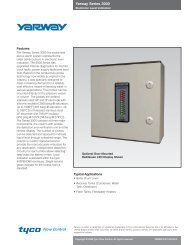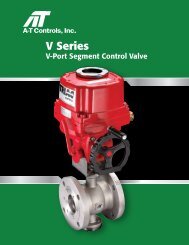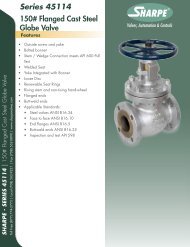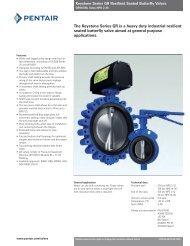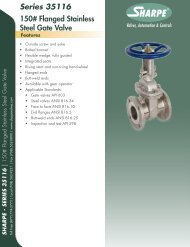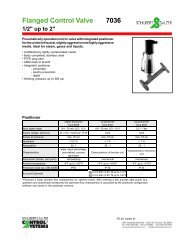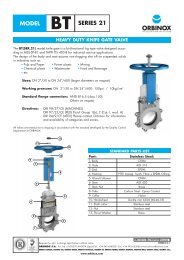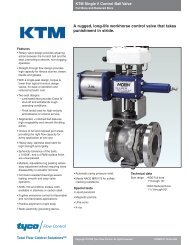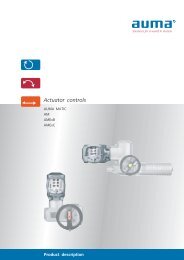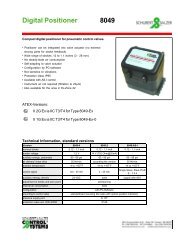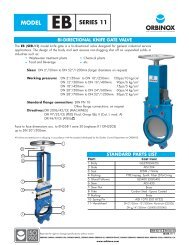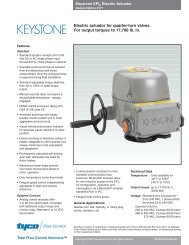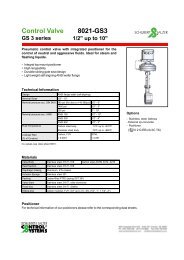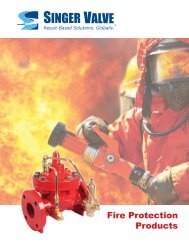Tideflex Mixing System Catalog - RM Headlee
Tideflex Mixing System Catalog - RM Headlee
Tideflex Mixing System Catalog - RM Headlee
Create successful ePaper yourself
Turn your PDF publications into a flip-book with our unique Google optimized e-Paper software.
Red Valve<br />
<strong>Tideflex</strong> ® in<br />
Drinking Water<br />
Reservoirs<br />
Eliminate Stagnation<br />
Figure 1 — Problem<br />
@@@@ €€€€ ÀÀÀÀ ,,,, yyyy<br />
@@@@ €€€€ ÀÀÀÀ ,,,, yyyy<br />
Stagnant<br />
Water<br />
Figure 2 — Solution<br />
@@@@ €€€€ ÀÀÀÀ ,,,, yyyy<br />
@@@@ €€€€ ÀÀÀÀ ,,,, yyyy<br />
Red Valve CFD Modeling will demonstrate<br />
the fluid dynamics of the system.<br />
@@@@ €€€€ ÀÀÀÀ ,,,, yyyy<br />
@@@@ €€€€ ÀÀÀÀ ,,,, yyyy<br />
@@@@ €€€€ ÀÀÀÀ ,,,, yyyy<br />
@@@@ €€€€ ÀÀÀÀ ,,,, yyyy<br />
@@@@ €€€€ ÀÀÀÀ ,,,, yyyy<br />
TIDEFLEX ®<br />
MIXING SYSTEM<br />
Finished water storage reservoirs have<br />
always had to contend with deterioration<br />
of water quality. Many reservoirs were<br />
designed solely to supply the required<br />
hydraulics of the distribution system, not<br />
necessarily to maintain water quality<br />
within the reservoir itself. The most common<br />
problem in reservoirs is the loss of<br />
chlorine or chloramine residual resulting<br />
from hydraulic short circuiting, poor mixing<br />
and circulation, poor turnover rate<br />
and excessive detention time. Stagnation<br />
and “dead spots” can lead to serious<br />
water quality issues such as the formation<br />
and multiplication of bacteria.<br />
Reservoirs can be circular, rectangular or<br />
irregularly shaped with capacities from a<br />
few hundred gallons to 50 million gallons<br />
or more. Many of these reservoirs are<br />
designed with common inlet/outlets or inlets<br />
and outlets that are within close proximity<br />
to one another. In this case, water close to<br />
the inlet and outlet is turned over and has<br />
adequate residual, but hydraulic short circuiting<br />
leads to stagnation and dead spots<br />
outside the inlet/outlet area of influence.<br />
See Figure 1.<br />
The <strong>Tideflex</strong> ® <strong>Mixing</strong> <strong>System</strong> (TMS) was<br />
developed to eliminate stagnation and dead<br />
spots by preventing hydraulic short circuiting,<br />
improving mixing and circulation and<br />
optimizing turnover rate and detention<br />
time. See Figure 2.<br />
The TMS is comprised of a manifold<br />
system with two sets of <strong>Tideflex</strong> ® Check<br />
Valves. One set is used to fill the reservoir,<br />
and the second set is used to drain the<br />
reservoir. <strong>Tideflex</strong> ® valves are completely<br />
manufactured of NSF-61-approved elastomers.<br />
The valves are passive, have no<br />
mechanical parts and require only differential<br />
head to operate — no outside energy<br />
source is needed. The <strong>Tideflex</strong> ® , coupled<br />
with PVC, stainless steel, ductile iron or<br />
any other suitable pipe material, creates<br />
an effective mixing system that requires<br />
no additional equipment and requires little<br />
or no maintenance.<br />
DESIGN ADVANTAGES<br />
The TMS <strong>System</strong> can be installed in new<br />
or existing reservoirs without the need to<br />
modify the structure — no excavation and<br />
no taps into the reservoir. The TMS is<br />
simply connected to a single inlet/outlet<br />
on one side of the tank.<br />
The entire TMS operates on differential<br />
pressure. The key is, this differential<br />
pressure is already in place and is used<br />
to fill and drain the reservoir. Compared<br />
to submersible mixers with high capital<br />
costs and high energy consumption, the<br />
TMS is very cost effective.<br />
Engineered rubber check sleeves have memory:<br />
forward hydraulic pressure opens valve,<br />
and reverse pressure seals the valve and prevents<br />
backflow.<br />
Jet Velocity<br />
Jet Velocity vs. Flow<br />
TIDEFLEX<br />
Fixed Orifice<br />
Flow<br />
<strong>Tideflex</strong> variable orifice enhances jet velocity<br />
at all fill rates, optimizing mixing.



